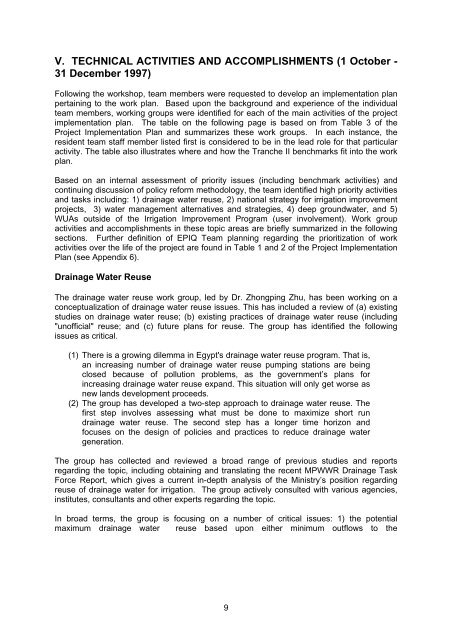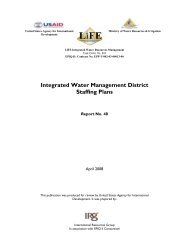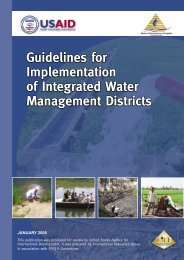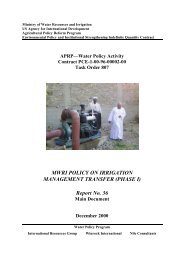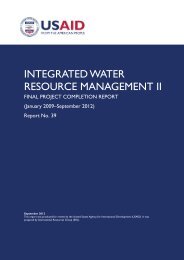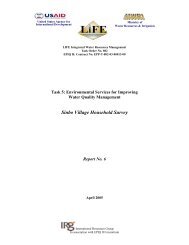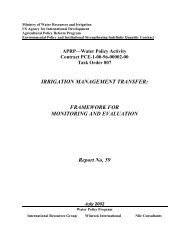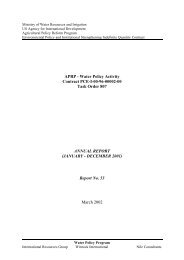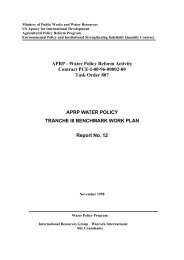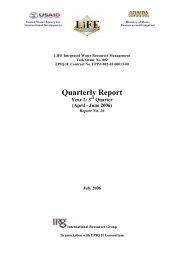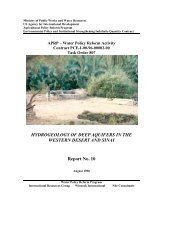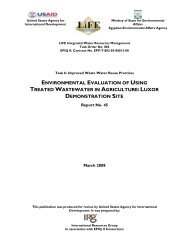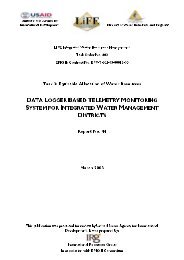APRP - Water Policy Reform - LIFE-IWRMII Project, Egypt
APRP - Water Policy Reform - LIFE-IWRMII Project, Egypt
APRP - Water Policy Reform - LIFE-IWRMII Project, Egypt
- No tags were found...
You also want an ePaper? Increase the reach of your titles
YUMPU automatically turns print PDFs into web optimized ePapers that Google loves.
V. TECHNICAL ACTIVITIES AND ACCOMPLISHMENTS (1 October -31 December 1997)Following the workshop, team members were requested to develop an implementation planpertaining to the work plan. Based upon the background and experience of the individualteam members, working groups were identified for each of the main activities of the projectimplementation plan. The table on the following page is based on from Table 3 of the<strong>Project</strong> Implementation Plan and summarizes these work groups. In each instance, theresident team staff member listed first is considered to be in the lead role for that particularactivity. The table also illustrates where and how the Tranche II benchmarks fit into the workplan.Based on an internal assessment of priority issues (including benchmark activities) andcontinuing discussion of policy reform methodology, the team identified high priority activitiesand tasks including: 1) drainage water reuse, 2) national strategy for irrigation improvementprojects, 3) water management alternatives and strategies, 4) deep groundwater, and 5)WUAs outside of the Irrigation Improvement Program (user involvement). Work groupactivities and accomplishments in these topic areas are briefly summarized in the followingsections. Further definition of EPIQ Team planning regarding the prioritization of workactivities over the life of the project are found in Table 1 and 2 of the <strong>Project</strong> ImplementationPlan (see Appendix 6).Drainage <strong>Water</strong> ReuseThe drainage water reuse work group, led by Dr. Zhongping Zhu, has been working on aconceptualization of drainage water reuse issues. This has included a review of (a) existingstudies on drainage water reuse; (b) existing practices of drainage water reuse (including"unofficial" reuse; and (c) future plans for reuse. The group has identified the followingissues as critical.(1) There is a growing dilemma in <strong>Egypt</strong>'s drainage water reuse program. That is,an increasing number of drainage water reuse pumping stations are beingclosed because of pollution problems, as the government’s plans forincreasing drainage water reuse expand. This situation will only get worse asnew lands development proceeds.(2) The group has developed a two-step approach to drainage water reuse. Thefirst step involves assessing what must be done to maximize short rundrainage water reuse. The second step has a longer time horizon andfocuses on the design of policies and practices to reduce drainage watergeneration.The group has collected and reviewed a broad range of previous studies and reportsregarding the topic, including obtaining and translating the recent MPWWR Drainage TaskForce Report, which gives a current in-depth analysis of the Ministry’s position regardingreuse of drainage water for irrigation. The group actively consulted with various agencies,institutes, consultants and other experts regarding the topic.In broad terms, the group is focusing on a number of critical issues: 1) the potentialmaximum drainage water reuse based upon either minimum outflows to the9


